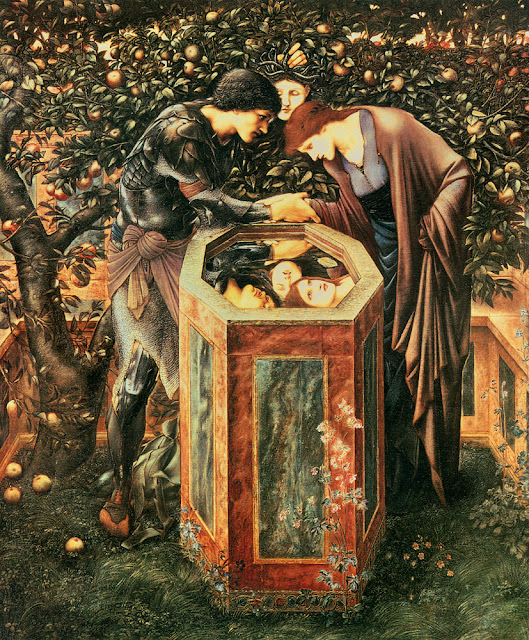At the weekend, I went to see the Pre-Raphaelite exhibition that is currently showing in London’s Tate Britain, “Pre-Raphaelites, Victorian Avant-Garde” billed as the first major show of these artists’ work in London for 25 years. It is definitely worth making the visit if you have any interest in the “Brotherhood” of artists that included John Everett Millais, Dante Gabriel Rossetti, William Holman Hunt, Ford Madox Brown and their younger followers William Morris and Edward Burne-Jones. There was a lot to take in as it is a very large exhibition spread through six rooms where you can see practically every significant painting by these revolutionary but also historically-inspired artists. More of the others later but my initial response was pleasure at seeing so many pieces by one of my favourite British artists, Edward Burne-Jones (1833-1898) who managed, in a complex balance between realism and dream-imagery, to create a world inspired by myths and legends and made hypnotic and erotic with painted images frozen in time and flattened onto the canvas with an eye that went back to pre-Renaissance art, pre-Raphael, but which also looks forward to the Symbolists and other later art movements.
I was particularly pleased to see three of Burne-Jones’ Perseus paintings side by side – they are usually in Stuttgart’s public gallery. I have only seen them as prints before and was immediately drawn to the richness of their colour and, as large paintings, the power of their impact. The three displayed show scenes from the Perseus legend when the hero, fresh from killing the Medusa (whose face turns anyone to stone who dares look at her unless it is seen as a mirrored reflection). He has spotted the beautiful Andromeda who has been chained to a rock in view of the ferocious sea monster the Kraken. Perseus kills the monster and wins the girl whilst keeping the Medusa’s severed head safely out of view in his handbag. In the final picture, The Baleful Head, he shows the head’s reflection to Andromeda.
This gory adventure story is rendered decorously with the characters frozen like those tableaux vivant popularised at Victorian pageants. The realism is minimal even though we recognise all the details. We are not there and could never go there. Perseus and Andromeda inhabit that other world somewhere inside our heads where we understand a different often abstract reality and where the Perseus legend is almost incidental to the paintings’ meaning. That, for me, is the special quality of Edward Burne-Jones’ work.
——————————————————————————————————————–
My novel, Stephen Dearsley’s Summer Of Love, was published on 31 October 2013. It is the story of a young fogey living in Brighton in 1967 who has a lot to learn when the flowering hippie counter culture changes him and the world around him.
It is now available as a paperback or on Kindle (go to your region’s Amazon site for Kindle orders)
…or from Amazon:





